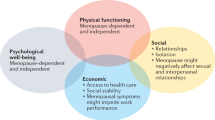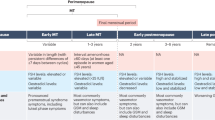Abstract
Heart disease presentation can differ between the sexes because nonobstructive coronary disease and angina unrelated to exercise are considerably more prevalent in women than in men. When the outcomes of large, randomized, controlled trials failed to demonstrate cardiac risk protection, many women and their physicians abandoned hormone replacement therapy as primary or secondary prevention for cardiovascular disease. We are concerned that the apparent blanket condemnation of steroids has not sufficiently distinguished between the cardiovascular actions of estrogen, progesterone and the synthetic progestin medroxyprogesterone acetate. The actions of active metabolites of progestins are not well understood and in some cases have not been explored. We intend to present what is known and what is not known about progesterone per se versus medroxyprogesterone acetate, particularly with regard to cardiovascular effects. This Review considers the mounting evidence that progesterone improves cardiovascular function and proposes its mechanism of action—restoration of a threshold level of progesterone as preventive of microvascular cardiac ischemia—and compares oral and transdermal routes of administration. We hope to stimulate research to determine whether progesterone, with or without estrogen, has a role in reducing cardiovascular risk and treating cardiovascular disease including myocardial ischemia in postmenopausal women.
Key Points
-
Unintentional confusion exists between medroxyprogesterone acetate (MPA) and progesterone in the scientific literature; MPA is in fact a progestin, it is not progesterone
-
Cardiovascular effects of the synthetic 24-carbon MPA are predominantly negative
-
Cardiovascular effects of endogenously identical 21-carbon progesterone are predominantly positive
-
Progesterone—alone or combined with estrogen—has never been tested as a treatment to prevent clinical cardiovascular disease
-
The HERS, WHI, WISDOM, and WISE studies all used MPA, not progesterone, in combination with Premarin®
-
Progesterone has not been tested in a large clinical trial to determine its cardiovascular effects in women, and there is no basis for attributing the adverse cardiovascular effects of synthetic MPA, which is well known to have androgen agonist activity, to progesterone, which does not
This is a preview of subscription content, access via your institution
Access options
Subscribe to this journal
Receive 12 print issues and online access
$209.00 per year
only $17.42 per issue
Buy this article
- Purchase on Springer Link
- Instant access to full article PDF
Prices may be subject to local taxes which are calculated during checkout
Similar content being viewed by others
References
Barrett-Connor E et al. (2005) The rise and fall of menopausal hormone therapy. Ann Rev Public Health 26: 115–140
Mosca L et al. (2004) Evidence-based guidelines for cardiovascular disease prevention in women. Circulation 109: 672–693
Manson JE et al.; WHI and WHI-CACS Investigators (2007) Estrogen therapy and coronary-artery calcification. N Engl J Med 356: 2591–2602
Quinkler M et al. (2002) Agonistic and antagonistic properties of progesterone metabolites at the human mineralocorticoid receptor. Eur J Endocrinology 146: 789–800
Stanczyk FZ (2003) All progestins are not created equal. Steroids 68: 879–890
Lu NZ et al. (2006) The pharmacology and classification of the nuclear receptor superfamily: glucocorticoid, mineralocorticoid, progesterone, and androgen receptors. Pharmacol Rev 58: 782–797
Faludi AA et al. (2004) Progesterone abolishes estrogen and/or atorvastatin endothelium dependent vasodilatory effects. Atherosclerosis 177: 89–96
Schulman SP et al. (2002) Effects of acute hormone therapy on recurrent ischemia in postmenopausal women with unstable angina. J Am Coll Cardiol 39: 231–237
Popp AW et al. (2006) Prevention of postmenopausal bone loss with long-cycle hormone replacement therapy. Maturitas 53: 191–200
Ghatge RP et al. (2005) The progestational and androgenic properties of medroxyprogesterone acetate: gene regulatory overlap with dihydrotesterone in breast cancer cells. Breast Cancer Research 7: R1036–R1050
Miyagawa K et al. (1997) Medroxyprogesterone interferes with ovarian steroid protection against coronary vasospasm. Nature Med 3: 324–327
Adams MR et al. (1997) Medroxyprogesterone acetate antagonizes inhibitory effects of conjugated equine estrogens on coronary artery atherosclerosis. Arterioscler Thromb Vasc Biol 17: 217–221
Hermsmeyer RK et al. (2004) Prevention of coronary hyperreactivity in preatherogenic menopausal rhesus monkeys by transdermal progesterone. Arterioscler Thromb Vasc Biol 24: 955–961
Mishra RJ et al. (2005) Medroxyprogesterone acetate and dihydrotestosterone induce coronary hyperreactivity in intact male rhesus monkeys. J Clin Endocrinol Metab 90: 3706–3714
Rosano GM et al. (2000) Natural progesterone, but not medroxyprogesterone acetate, enhances the beneficial effect of estrogen on exercise-induced myocardial ischemia in postmenopausal women. J Am Coll Cardiol 36: 2154–2159
Wright DW et al. (2007) ProTECT: a randomized clinical trial of progesterone for acute traumatic brain injury. Ann Emerg Med 49: 391–402
Sitruk-Ware RL (2003) Hormone therapy and the cardiovascular system: the critical role of progestins. Climacteric 6 (Suppl 3): 21–28
Skouby SO et al. (2007) A comparative study of the effect of continuous combined conjugated equine estrogen plus medroxyprogesterone acetate and tibolone on blood coagulability. Hum Reprod 22: 1186–1191
Canonico M et al.; EStrogen and THromboEmbolism Risk (ESTHER) Study Group (2007) Hormone therapy and venous thromboembolism among postmenopausal women. Circulation 115: 840–845
Minshall R et al. (2001) Progesterone regulation of vascular thromboxane A(2) receptors in rhesus monkeys. Am J Physiol 281: H1498–H1507
Otsuki M et al. (2001) Progesterone, but not medroxyprogesterone, inhibits vascular cell adhesion molecule-1 expression in human vascular endothelial cells. Arterioscler Thromb Vasc Biol 21: 243–248
Simoncini T et al. (2004) Differential signal transduction of progesterone and medroxyprogesterone acetate in human endothelial cells. Endocrinology 145: 5745–5756
King RJ and Whitehead MI (1986) Assessment of the potency of orally administered progestins in women. Fertil Steril 46: 1062–1066
Ciriza I et al. (2006) Reduced metabolites mediate neuroprotective effects of progesterone in the adult rat hippocampus: the synthetic progestin medroxyprogesterone acetate (Provera) is not neuroprotective. J Neurobiol 66: 916–928
Nilsen J and Brinton RD (2003) Divergent impact of progesterone and medroxyprogesterone acetate (Provera) on nuclear mitogen-activated protein kinase signaling. Proc Nat Acad Sci USA 100: 10506–10511
Hulley S et al. (1998) Randomized trial of estrogen plus progestin for secondary prevention of coronary heart disease in postmenopausal women. Heart and Estrogen/progestin Replacement Study (HERS) research group. JAMA 280: 605–613
Rossouw JE et al. (2007) Postmenopausal hormone therapy and risk of cardiovascular disease by age and years since menopause. JAMA 297: 1465–1477
Rossouw JE et al.; Writing Group for the Women's Health Initiative Investigators (2002) Risks and benefits of estrogen plus progestin in healthy postmenopausal women: principal results From the Women's Health Initiative randomized controlled trial. JAMA 288: 321–333
Vickers MR et al.; WISDOM Group (2007) Main morbidities recorded in the women's international study of long duration oestrogen after menopause (WISDOM): a randomised controlled trial of hormone replacement therapy in postmenopausal women. BMJ 235: 339–351
The Postmenopausal Estrogen/Progestin Interventions (PEPI) Trial (1995) Effects of estrogen or estrogen/progestin regimens on heart disease risk factors in postmenopausal women. JAMA 273: 199–208
Buchthal SD et al. (2000) Abnormal myocardial phosphorus-31 nuclear magnetic resonance spectroscopy in women with chest pain but normal coronary angiograms. N Engl J Med 342: 829–835
Wang L et al. (2006) Coronary risk factors and myocardial perfusion in asymptomatic adults: the Multi-Ethnic Study of Atherosclerosis (MESA). J Am Coll Cardiol 47: 565–572
Wang JJ et al. (2006) Retinal vascular calibre and risk of coronary heart disease-related death. Heart 92: 1583–1587
Kaski JC (2004) Pathophysiology and management of patients with chest pain and normal coronary arteriograms (cardiac syndrome X). Circulation 109: 568–572
Eichling PS and Sahni J (2005) Menopause related sleep disorders. J Clin Sleep Med 15: 291–300
Wesström J et al. (2005) Sleep apnea and hormone replacement therapy: a pilot study and a literature review. Acta Obstet Gynecol Scand 84: 54–57
Anderson ML et al. (2006) Effects of progesterone on sleep: a possible pharmacological treatment for sleep-breathing disorders? Curr Med Chem 13: 3575–3582
Hays J et al.; Women's Health Initiative Investigators (2003) Effects of estrogen plus progestin on health-related quality of life. N Engl J Med 348: 1839–1854
Asplund R and Aberg H (1998) Sleep and cardiac symptoms amongst women aged 40–64 years. J Intern Med 243: 209–213
Kotorii T et al. (1987) Effects of medroxyprogesterone acetate on sleep of healthy young male adults. Jpn J Psychiatry Neurol 41: 261–267
Rosano GM and Fini M (2001) Comparative cardiovascular effects of different progestins in menopause. Int J Fertil Womens Med 46: 248–256
Hudson R et al. (1978) Preclinical evaluation of intrauterine progesterone as a contraceptive agent III. Embryology and toxicology. Contraception 17: 489–497
Dimera Incorporated (2000 ) DP9 progesterone 2% topical cream to treat angina pectoris. IND 60,595
Parker WH et al. (2005) Ovarian conservation at the time of hysterectomy for benign disease. Obstet Gynecol 106: 219–226
Missmer SA et al. (2004) Endogenous estrogen, androgen, and progesterone concentrations and breast cancer risk among postmenopausal women. J Natl Cancer Inst 96: 1856–1865
Horwitz KB et al. (1988) Progesterone receptor replenishment inT47D human breast cancer cells: roles of protein synthesis and hormone metabolism. J Biol Chem 258: 7603–7610
Sturm G et al. (1991) Mass spectrometric and high-performance liquid chromatographic studies of medroxyprogesterone acetate metabolites in human plasma. J Chromatogr 562: 351–362
Shifren JL et al. (2008) A comparison of the short-term effects of oral conjugated equine estrogens vs. transdermal estradiol on c-reactive protein, other serum markers of inflammation and other hepatic proteins in naturally menopausal women. J Clin Endocrinol Metab [10.1210/jc.2007-2193]
Cushman M et al. (1999) Hormone replacement therapy, inflammation, and hemostasis in elderly women. Arterioscler Thromb Vasc Biol 19: 893–899
Vehkavaara S et al. (2001) Effects of oral and transdermal estrogen replacement therapy on markers of coagulation, fibrinolysis, inflammation and serum lipids and lipoproteins in postmenopausal women. Thromb Haemost 85: 619–625
Samsioe G et al.; Estalis 50/140 Study Group (2006) Endometrial safety, overall safety and tolerability of transdermal continuous combined hormone replacement over 96 weeks: a randomized open-label study. Climacteric 9: 368–379
Paris JM et al. (2000) Nomegestrol acetate and vascular reactivity: nonhuman primate experiments. Steroids 65: 621–627
Cicinelli E et al. (2002) Twice weekly transdermal estradiol and vaginal progesterone as continuous combined hormone replacement therapy in postmenopausal women: a 1-year prospective study. Am J Obstet Gynecol 187: 556–560
Scarabin PY et al.; EStrogen and THromboEmbolism Risk Study Group (2003) Differential association of oral and transdermal oestrogen-replacement therapy with venous thromboembolism risk. Lancet 362: 428–432
Stanczyk FA (1999) Pharmacokinetics of progesterone administered by the oral and parenteral routes. J Reprod Med 44: 141–147
Acknowledgements
The authors acknowledge the contributions of Barbara Wexler to the presentation of this manuscript.
Author information
Authors and Affiliations
Corresponding author
Ethics declarations
Competing interests
RK Hermsmeyer is an employee of Dimera Incoporated, which is carrying out clinical trials with a transdermal drug product containing progesterone. He has received grant/research support from, and is a Stock holder/Director and Patent Holder/Applicant for Dimera Incorporated. He has also received grant support from Theraméx Pharmaceuticals of Monaco (now a division of E Merck Darmstadt) and Berlex (now a division of Bayer) for projects with synthetic progestins.
TL Thompson is an employee of and has received grant/research support from Dimera Incoporated, which is carrying out clinical trials with a transdermal drug product containing progesterone.
GM Pohost has received grant/research support from, and is a Stock Holder/Director for Salick Cardiovascular Centers, Los Angeles, CA.
Rights and permissions
About this article
Cite this article
Hermsmeyer, R., Thompson, T., Pohost, G. et al. Cardiovascular effects of medroxyprogesterone acetate and progesterone: a case of mistaken identity?. Nat Rev Cardiol 5, 387–395 (2008). https://doi.org/10.1038/ncpcardio1234
Received:
Accepted:
Published:
Issue Date:
DOI: https://doi.org/10.1038/ncpcardio1234



